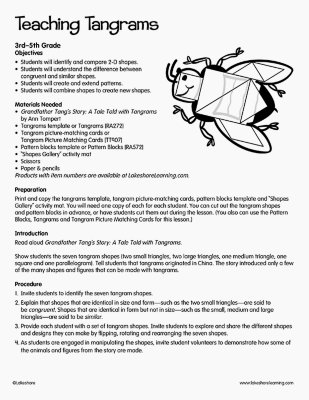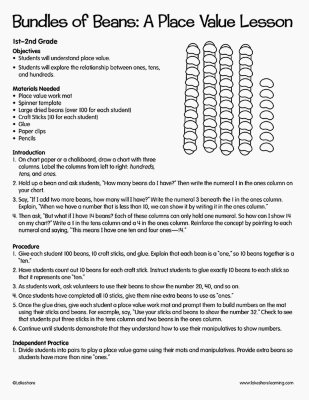Narrow by Grade
- Infant (0)
- Toddler (0)
- Preschool (0)
- Pre-K (0)
- Kindergarten (0)
- 1st (1)
- 2nd (2)
- 3rd (0)
- 4th (0)
- 5th (0)
- 6th & Up (0)
Grade
Narrow by Age
- 0-18m (3)
- 18-36m (2)
- 3 yrs. (0)
- 4 yrs. (2)
- 5 yrs. (4)
- 6 yrs. (1)
- 7 yrs. (2)
- 8 yrs. (3)
- 9 yrs. (4)
- 10 yrs. (1)
- 11 yrs. & Up (0)
Age 7 yrs.
2 results for "giant"
Filters
Clear All
Teaching Tangrams
2nd Grade
Objectives Students will identify and compare 2-D shapes. Students will understand the difference between congruent and similar shapes. Students will create and extend patterns. Students will combine shapes to create new shapes. Materials Needed Grandfather Tang’s Story: A Tale Told with Tangrams by Ann Tompert Tangrams template or Tangrams Tangram picture-matching cards or Tangram Picture Matching Cards Pattern blocks template or Pattern Blocks “Shapes Gallery” activity mat Scissors Paper & pencils Preparation: Print and copy the tangrams template, tangram picture-matching cards, pattern blocks template and “Shapes Gallery” activity mat. You will need one copy of each for each student. You can cut out the tangram shapes and pattern blocks in advance, or have students cut them out during the lesson. (You also can use the Pattern Blocks, Tangrams and Tangram Picture Matching Cards for this lesson.) Introduction Read aloud Grandfather Tang’s Story: A Tale Told with Tangrams. Show students the seven tangram shapes (two small triangles, two large triangles, one medium triangle, one square and one parallelogram). Tell students that tangrams originated in China. The story introduced only a few of the many shapes and figures that can be made with tangrams.
View Lesson PlanBundles of Beans: A Place Value Lesson
1st Grade - 2nd Grade
Objectives Students will understand place value. Students will explore the relationship between ones, tens, and hundreds. Materials Needed Place value work mat Spinner template Large dried beans (over 100 for each student) Craft Sticks (10 for each student) Glue Paper clips Pencils Introduction On chart paper or a chalkboard, draw a chart with three columns. Label the columns from left to right: hundreds, tens, and ones. Hold up a bean and ask students, “How many beans do I have?” Then write the numeral 1 in the ones column on your chart. Say, “If I add two more beans, how many will I have?” Write the numeral 3 beneath the 1 in the ones column. Explain, “When we have a number that is less than 10, we can show it by writing it in the ones column.” Then ask, “But what if I have 14 beans? Each of these columns can only hold one numeral. So how can I show 14 on my chart?” Write a 1 in the tens column and a 4 in the ones column. Reinforce the concept by pointing to each numeral and saying, “This means I have one ten and four ones—14.”
View Lesson Plan
